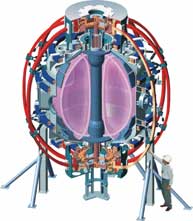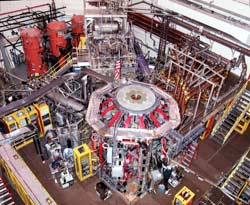 |
| National Spherical Torus Experiment | |
 |
 |
| Schematic of the NSTX | National Spherical Torus Experiment |
|
The National Spherical Torus Experiment (NSTX) is an innovative magnetic fusion device that was constructed by the Princeton Plasma Physics Laboratory (PPPL) in collaboration with the Oak Ridge National Laboratory, Columbia University, and the University of Washington at Seattle. First plasma was obtained on NSTX on Friday, February 12, 1999 at 6:06 p.m. NSTX is being used to study the physics principles of spherically shaped plasmas -- hot ionized gases in which nuclear fusion will occur under the appropriate conditions of temperature, density, and confinement in a magnetic field. Fusion is the energy source of the Sun and all the stars. Scientists believe it can provide an inexhaustible, safe, and environmentally attractive source of energy on earth. Magnetic fusion experiments use plasmas comprised of one or more of the isotopes of hydrogen. For example, in 1994, PPPL's Tokamak Fusion Test Reactor (TFTR) produced a world-record 10.7 million watts of fusion power from a plasma comprised of equal parts of deuterium and tritium, the fuel mix likely to be used in commercial fusion power reactors. NSTX is a "proof of principle" experiment and therefore employs deuterium plasmas only. If successful it will be followed by similar devices, eventually including a demonstration power reactor, burning deuterium-tritium fuel. NSTX produces a plasma that is shaped like a sphere with a hole through its center, different from the "donut" shaped plasmas of conventional tokamaks. This innovative plasma configuration may have several advantages, a major one being the ability to confine a higher plasma pressure for a given magnetic field strength. Since the amount of fusion power produced is proportional to the square of the plasma pressure, the use of spherically shaped plasmas could allow the development of smaller, more economical fusion reactors. NSTX's attractiveness may be further enhanced by its ability to produce a high "bootstrap" electric current. This self-driven internal plasma current would significantly reduce the power requirements of externally driven plasma currents required to heat and confine the plasma. Additional Information on NSTX:
(Some of the documents listed above are in PDF format. You will need Acrobat Reader to view them. A free copy of Acrobat Reader can be downloaded from Adobe's Web Site.) |